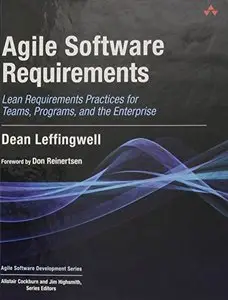Agile Software Requirements: Lean Requirements Practices for Teams, Programs, and the Enterprise (Agile Software Development Series) by Dean Leffingwell
English | Jan. 6, 2011 | ISBN: 0321635841 | 559 Pages | PDF | 19 MB
English | Jan. 6, 2011 | ISBN: 0321635841 | 559 Pages | PDF | 19 MB
“We need better approaches to understanding and managing software requirements, and Dean provides them in this book. He draws ideas from three very useful intellectual pools: classical management practices, Agile methods, and lean product development. By combining the strengths of these three approaches, he has produced something that works better than any one in isolation.”
–From the Foreword by Don Reinertsen, President of Reinertsen & Associates; author of Managing the Design Factory; and leading expert on rapid product development
Effective requirements discovery and analysis is a critical best practice for serious application development. Until now, however, requirements and Agile methods have rarely coexisted peacefully. For many enterprises considering Agile approaches, the absence of effective and scalable Agile requirements processes has been a showstopper for Agile adoption. In Agile Software Requirements, Dean Leffingwell shows exactly how to create effective requirements in Agile environments.
Part I presents the “big picture” of Agile requirements in the enterprise, and describes an overall process model for Agile requirements at the project team, program, and portfolio levels
Part II describes a simple and lightweight, yet comprehensive model that Agile project teams can use to manage requirements
Part III shows how to develop Agile requirements for complex systems that require the cooperation of multiple teams
Part IV guides enterprises in developing Agile requirements for ever-larger “systems of systems,” application suites, and product portfolios



